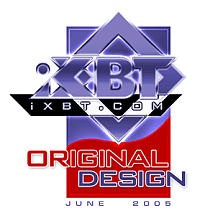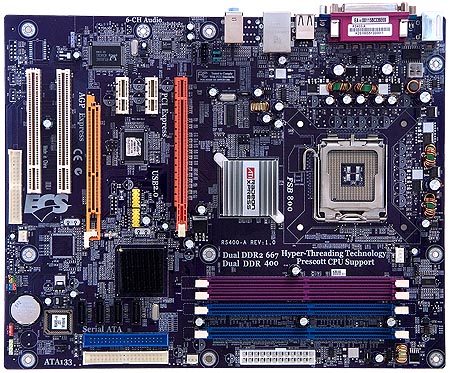 |
||
|
||
| ||
Since the appearance of DDR2 memory modules, we have often come across motherboards that allow gradual upgrade to the new memory type by supporting both DDR and DDR2. As DDR2 modules were initially noticeably more expensive than DDR, this approach could be quite relevant to many users. But think about this - there is a similar situation with AGP and PCI Express graphics interfaces, and ECS engineers came up with a reasonable idea: "Why not equip a motherboard not only with slots for two memory types, but also with PCIEx16 and AGP (in addition to the integrated video in the chipset)?" Dictum-factum, but as the ATI Xpress 200 chipset (for both platforms) does not support AGP bus and there are no miracles, the miraculous AGP Express slot is just an overhauled PCI slot (that is it's connected to the chipset via the PCI bus, it's just designed in the AGP 4x/8x form factor). It certainly has a baleful effect on the system performance with an AGP video accelerator in modern games — we have already reviewed this issue in detail. So today we shall limit ourselves to a small number of tests for confirmation. Thus, AGP on the RS400-A may be useful only if you already have an AGP video card and do not have enough money to upgrade to a PCI Express video card so far (or if you are not interested in 3D performance at all). Note that the so called AGP Express is not guaranteed to support all video cards, the list of models checked for compatibility is published in User's Guide on the official web site.
Support for two memory types (not simultaneously) and three (!) graphics adapter types merits the Original Design award:

Quite a ponderable disadvantage is that this motherboard can accommodate only two memory modules [of the selected type] not exceeding the total size of 2 GB, while the majority of modern solutions support 4 modules/8 (or even 16) GB of memory. That is the ECS RS400-A is obviously not intended for a high-performance workstation, it's rather a solution for home users, who upgrade their computers gradually. Motherboard features are scarce: there are no additional IDE and SATA controllers or FireWire support (though there is an empty seat for it on the PCB, that is some future model may have it), the network adapter is limited to 10/100 Mbit/s (Fast Ethernet), the audio system is based on an AC'97 codec, despite the growing popularity of HDA. But the price to consumer justifies all these disadvantages in the eyes of many customers.  Perhaps the only disadvantage in the PCB layout, which is not overcrowded with integrated controllers and connectors, is that the FDD connector is located behind the last PCI slot: when a high-profile expansion card is installed into this slot, it's very difficult to manipulate an FDD cable; besides, this cable may be not long enough for a high tower. Access to the jumpers is not hampered even when the motherboard is installed in a case. There are brief descriptions of jumper functions on the PCB. The 4-phase switching voltage regulator of the processor incorporates 13 x 1500 uF capacitors (manufactured by OST, which reputation is not very good). The memory voltage regulator uses four 1000 uF capacitors reinforced with L elements. The motherboard has empty seats for a FireWire controller, a connector for a bracket with ports, WOL, WOM connectors, and a connector for a bracket with an additional COM port. Motherboard dimensions — 305x245 mm (standard ATX, ten-screw mount, all motherboard edges are firmly fixed). System monitoring (ITE IT8712F-A):
Onboard ports, sockets, and connectors
Back panel (left to right, blockwise) Click the image to open the rear view of this motherboard
Package Contents
The poverty of the bundle matches the functionality of this model, but on the other hand, it contributes to the low price. Integrated Controllers
The integrated audio quality was tested in 16bit, 44 kHz using the RightMark
Audio Analyzer 5.5 test application and the Terratec
DMX 6fire sound card:
General performance: Good (Details). The intermodulation distortion level at the analog output does not deserve good comments. In other respects it's OK. Settings
We used BIOS 1.0e, the latest available BIOS version at the time of our tests. The mentioned BIOS parameters are available in this version, but the viability of non-standard settings hasn't been tested. Preliminary test resultsTestbed configurations:
The table below contains the results of the motherboard under review with
Intel Pentium 4 EE 3.46 GHz. Indeed, this chipset does not support
1066 FSB officially, but it correctly detected this processor
and ran it at the "native" clock — it's not for the first time
that ATI "palters" with FSB frequency support specs. As we have
learnt from semi-official sources, ATI just hasn't yet completed negotiations
with Intel about the official 1066 MHz FSB support (it requires
special licensing). That's why the official chipset specifications
shy away the fact that FSB can operate at this frequency. We compared
the ECS RS400-A with the fastest (according to the roundup
of six motherboards) representative of the i925XE chipset —
Gigabyte 8AENXP-D.
Well, the i925XE is noticeably faster, our tests demonstrate the 5—8% difference. However, it will hardly scare you away, if you want to buy the ECS RS400-A — this motherboard is initially not intended to be a top model.
Remember that we have already reviewed in detail the performance drop, when a video card is installed into AGP Express slot compared to regular AGP. Nevertheless, we had to make sure that the performance drop was still there. In this case we confined ourselves to the available results of the ECS 865PE-A7 motherboard on i865PE (with native AGP 8x) — they were obtained with Pentium 4 560 (3.6 GHz). The ECS RS400-A had to be tested with Pentium 4 550 (3.4 GHz), currently available in our lab. Thus, the systems are formally at long odds, but have a look at the game results in low resolutions, obtained with one of the most powerful AGP video cards — ATI Radeon 9800 Pro.
No comments. It's clear that extra 200 MHz in CPU clock and a generally faster chipset cannot make up for 30—50% lag in the AGP Express modification. However, even if the ECS RS400-A is outperformed with its two graphics interfaces, it still has a trump card of the integrated video, a counterpart of ATI Radeon X300 (ATI Radeon 9600). It goes without saying that you cannot expect from integrated video high performance in heavy gaming modes. But it's still one of the most attractive integrated solutions that offers entry-level gaming performance. We are soon going to review the features of ATI Xpress 200 IE in comparison with competing integrated video solutions in a separate article. ConclusionsECS RS400-A is a motherboard designed specially for gradual and as cheap as possible upgrade to the new standards in home and office computers. And I should say that this model copes with its tasks very well. I repeat that you had better not use it for anything bigger. The only obvious advantage of this model is good graphics integrated into the ATI Radeon Xpress 200 chipset, the negative side is low performance with an external video accelerator. Poor functionality and bundle is a reasonable compromise to cut down the costs. The original design of this motherboard allows installing any of the two memory types, but the AGP option comes at a cost of reduced performance.
This model on the manufacturer's web site (Russian mirror)
The motherboard is kindly provided by the manufacturer
Write a comment below. No registration needed!
|
Platform · Video · Multimedia · Mobile · Other || About us & Privacy policy · Twitter · Facebook Copyright © Byrds Research & Publishing, Ltd., 1997–2011. All rights reserved. | |||||||||||||||||||||||||||||||||||||||||||||||||||||||||||||||||||||||||||||||||||||||||||||||||||||||||||||||||||||||||||||||||||||||||||||||||||||